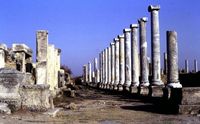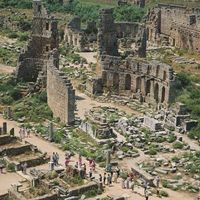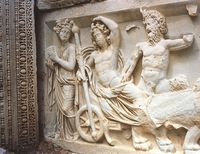Perge was established around 1500 B.C. St Paul visited the important Roman city, and reputedly preached his first sermon there. It is a fascinating site for enthusiasts of archaeology.
History
Perge was sited inland as a defensive measure, in order to avoid the pirate bands that terrorized this stretch of the Mediterranean.
During the Hellenistic period Perge was one of the richest and most beautiful cities in the world. It was famous for its temple of the local goddess Artemis Pergaia (not to be confused with the Greek Artemis) – the site of the temple has not yet been found.
In 546 B.C., the Achaemenid Persians defeated the local powers and gained control of the Pamphylia region.
In 333 B.C., during the war of conquest against the Persians, the armies of Alexander the Great arrived in Perge. The citizens of Perge sent out guides to lead his army into the city. After his death, Perge came under the control of the Seleucids and, later, of Pergamum (on the Aegean coast).
Perge's most celebrated inhabitant, the mathematician Apollonius of Perge (c.262 B.C. – c.190 B.C.), was a pupil of Archimedes. By this time it was clearly understood that Earth is round and that it rotates around the sun. He wrote a series of eight books describing a family of curves known as conic sections, comprising the circle, ellipse, parabola and hyperbola.
In 188 B.C. Perge came under Roman rule.
The Christian Saints Paul and Barnabas visited Perge twice, as recorded in the Acts of the Apostles. During their first missionary journey, they “preached the word" there (Acts 14:25) before sailing from Attalia (modern day Antalya city) to Antioch (in modern day Syria).
Perge was inhabited until Seljuk times, then it was gradually abandoned.
Archaeology
Perge is the site of an acropolis dating back to the Bronze Age.
Most of the ruins visible today date from the Roman period. They include a 12,000 seat theatre, a palaestra (Ancient Greek wrestling school), a large bath house, a nymphaeum, and a 300 metre colonnaded avenue.
Key Facts
- Perge is located 122 km from Alanya, on the west side.
Shorex: Full day, could be combined with 14.





